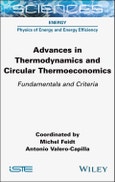This book on energy physics and energy efficiency discusses two essential components of energy physics: the fundamentals and the criteria.
It covers the historical basis of Carnot models, the thermostatic cycles of double-function heat pumps and the optimization of thermomechanical engines, and discusses the results of various investigations, bringing together a number of previous works.
The latter half of this book introduces the concept of "Circular Thermoeconomics" and assesses the physical costs of recycling waste in increasingly complex industrial processes. It then goes on to present "Relative Free Energy", allowing us to create a new mathematical theory of thermodynamic costs in order to diagnose malfunctions in thermal systems.
The book shows the progression of knowledge on the existence of successive energy, power and efficiency, and pairs this with the economic aspects, which are already becoming linked to growing environmental concerns.
Table of Contents
Foreword xi
Michel FEIDT
Introduction xiii
Michel FEIDT and Antonio VALERO-CAPILLA
Chapter 1 From Equilibrium Thermodynamics to Irreversible Thermodynamics 1
Michel FEIDT
1.1 Recent emergence of thermodynamics: from heat to engines 1
1.1.1 Heat and temperature 1
1.1.2 Matter and chemical reactions 2
1.1.3 Mechanical energy 3
1.1.4 Heat-work equivalence 4
1.2 From engines to concepts (work by Carnot) 5
1.2.1 The steam engine and other engines 5
1.2.2 The Carnot cycle 5
1.2.3 Carnot efficiency 8
1.2.4 Engine power 8
1.3 From thermostatics to thermodynamics 9
1.3.1 The basics of thermodynamics 10
1.3.2 Thermodynamic transformation 14
1.3.3 Energy transfers and conversion 18
1.3.4 Generalization of cycle and efficiency concepts 22
1.4 Case study: the Carnot engine 25
1.4.1 Energy and entropy balances 25
1.4.2 Entropy production and energy efficiency 27
1.5 First conclusions and perspectives 34
1.6 References 35
Chapter 2 Two-Heat-Source Thermodynamic Cycles: Representation as a Ternary Diagram 37
Julien RAMOUSSE
2.1 Introduction to two-heat-source systems 37
2.2 Definitions and convention 38
2.2.1 Work and heat 38
2.2.2 Sign convention 39
2.2.3 Heat source/sink 40
2.2.4 First-law balance 40
2.2.5 Second-law balance 41
2.3 Graphic representations - state of the art 44
2.3.1 Q-T diagram 45
2.3.2 Borel and Favrat diagram 46
2.3.3 Raveau diagram 49
2.4 Ternary diagram 50
2.4.1 Ternary diagram representation 51
2.4.2 Interpretation using polar coordinates 56
2.5 Application examples 62
2.5.1 Endo-reversible (exo-irreversible) two-heat-source systems 63
2.5.2 Exo-reversible (endo-irreversible) two-heat-source systems 66
2.5.3 General case - endo- and exo-irreversible systems 71
2.6 Conclusion and prospects 74
2.7 References 77
Chapter 3 Thermodynamics with Finite Speed 79
Stoian PETRESCU and Monica COSTEA
3.1 Introduction 79
3.2 First developments of TFS (1964-1974) 80
3.2.1 The origin of TFS 80
3.2.2 Fundamental concepts 82
3.2.3 The first law of thermodynamics for finite-speed processes in simple systems 85
3.2.4 First approach to Beau de Rochas and Otto's finite speed irreversible cycle 92
3.3 Developments of TFS during the period 1990-2007 94
3.3.1 First law of thermodynamics for finite speed processes in complex closed systems 94
3.3.2 The direct method of TFS 98
3.4 Main achievements of TFS and the direct method 99
3.4.1 Modeling and optimization of the Stirling engine cycle 99
3.4.2 Optimization of the Carnot engine irreversible cycle 108
3.4.3 Effect of irreversibilities on the efficiency of the Beau de Rochas-Otto cycle at finite speed 112
3.4.4 Optimization of diesel cycle efficiency at finite speed 113
3.5 New developments and extension of TFS 115
3.6 International recognition of TFS and the direct method 117
3.7 Conclusion 117
3.8 References 118
Chapter 4 Finite Physical Dimensions Thermodynamics 125
Michel FEIDT
4.1 Introduction 125
4.2 The Carnot engine according to equilibrium thermodynamics 126
4.2.1 Equilibrium thermodynamics and heat losses 126
4.2.2 Exo-reversible Carnot engine (endo-irreversible) 128
4.2.3 Power of the exo-reversible Carnot engine 129
4.3 The Chambadal engine model (1957) 130
4.3.1 Optimization of the modified Chambadal engine without source-converter heat transfer coupling constraint 131
4.3.2 Optimization of the modified Chambadal engine, with the transfer entropy constraint 133
4.3.3 Section conclusion 134
4.4 The Curzon-Ahlborn model (1975) 134
4.4.1 Optimization of mechanical energy 136
4.4.2 Optimization of mechanical power 138
4.5 Finite speed thermodynamics 139
4.5.1 Introduction 139
4.5.2 Expression of the first law of thermodynamics for finite speed processes 140
4.5.3 Extension of the method 140
4.6 Finite physical dimensions optimal thermodynamics: case without coupling of sources and sinks with the converter 141
4.7 Finite physical dimensions optimal thermodynamics: case with source and sink coupling with the converter 143
4.7.1 Irreversible Carnot engine with finite source and sink 145
4.7.2 Irreversible Carnot engine with finite converter 145
4.8 Chapter conclusion 147
4.9 Appendix 148
4.10 References 149
Chapter 5 Circular Thermoeconomics: A Waste Cost Accounting Theory 151
Antonio VALERO-CAPILLA and César TORRES
5.1 Introduction 152
5.1.1 Toward a general theory of process efficiency 155
5.1.2 Basic concepts 157
5.2 The exergy cost theory 159
5.2.1 The principle of non-equivalence of local irreversibilities 166
5.2.2 The cost formation process of waste 168
5.2.3 Waste flows cost allocation 172
5.2.4 Exergy cost computation 175
5.3 Structural theory of thermoeconomics 178
5.3.1 Marginal cost equations 182
5.3.2 Linear model of characteristic equations 184
5.4 Structural theory and exergy cost 185
5.4.1 The flow-process model 189
5.4.2 The characteristic equations of exergy cost theory 194
5.4.3 The fuel impact formula 197
5.4.4 Cost decomposition 198
5.4.5 Efficiency and recycling 201
5.5 Conclusion 204
5.5.1 The structural theory 204
5.5.2 Circular economy and industrial symbiosis 206
5.6 References 210
Chapter 6 The Relative Free Energy Function: A New Approach to Thermoeconomic Diagnosis 215
Antonio VALERO-CAPILLA and César TORRES
6.1 Introduction 216
6.2 Drawbacks of exergy 219
6.3 The relative free energy function 220
6.4 h-s deterioration(s) path(s) of an energy system 223
6.5 The Legendre transform of a deterioration path 224
6.6 Conclusion 229
6.7 Epilogue 232
6.8 References 236
List of Authors 239
Index 241








